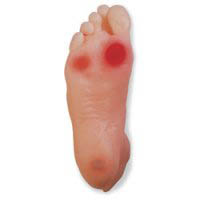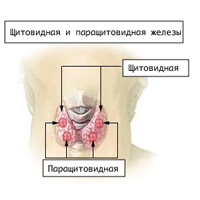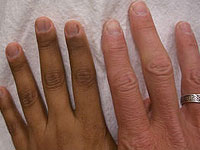The development of the diabetic foot is associated with the defeat of the nerves and vessels of the limbs. The form of the diabetic foot depends on the predominance of the pathological component. All signs of diabetes, which celebrates the patient himself, are divided into complaints and signs.
Content
Fork damage for diabetes mellitus
 The development of the diabetic foot is the consequence of the damage to the nerves and vessels of the limbs during diabetes. Depending on the prevalence of this or that pathological component, the following types of diabetic foot syndrome are distinguished:
The development of the diabetic foot is the consequence of the damage to the nerves and vessels of the limbs during diabetes. Depending on the prevalence of this or that pathological component, the following types of diabetic foot syndrome are distinguished:
- Neuropathic diabetic stop
- Ischemic diabetic stop
- Mixed form of diabetic foot
Neuropathic diabetic stop is characterized by trophic changes in the lower limb arising against the background of the damage of the nervous foot apparatus. Signs of the neuropathic foot - dryness and peeling of the skin, reducing the sweating, the deformation of the bones of the foot, spontaneous fractures, flatfoot, decrease the sensitivity of the foot to heat, touch, pain.
Ischemic diabetic stop - forms due to the lesion of large (atherosclerosis) and small (microangiopathy) limb vessels. The name of the pathology (ischemic stop) suggests that in this case, the trophic changes of the foot tissues occur due to violation of blood circulation and lack of oxygen in the leg tissues. Signs of ischemic feet - pronounced, resistant swelling of the foot, leg pain during walking (intermittent chromota), fast fatigue, pigmentation of the skin, the appearance of blisters.
The mixed form of the diabetic foot is characterized by the presence and nervous and vascular trophic stop changes. This form of the diabetic foot is most often found in patients with large «Trade» Sugar diabetes. The mixed type of diabetic foot is manifested by the signs of both types of pathology described above.
The risk of developing the diabetic foot exists in all patients with diabetes without exception, but the most likely to develop this complication of diabetes is observed in the following categories of patients:
- Patients suffering from peripheral polynereropathy or various diseases of blood vessels
- Patients who have ulcers of limbs or amputation in the past
- Patients abusing alcohol and tobacco
- Patients with hypertension and elevated blood cholesterol
- Patients with any other complications of diabetes
- Patients with violations of vision
Signs of diabetic foot
All patients with diabetes should be carefully referring to the state of their feet and notice any «Possible signs» Development of Diabetic Foot.
Signs of the diabetic foot, which can be marked by the patient himself, can be divided into complaints and signs.
Complaints characteristic of diabetic foot
The appearance of unpleasant feelings in the legs, stitching or burning pain, «Running geasses», «electricity» and the disappearance of these sensations when walking may indicate the beginning of the development of neuropathic diabetic foot. Another sign of the diabetic foot may be a violation or disappearance of the sensitivity of the stop.
The appearance of strong pain when walking, as well as the appearance of pain at night, which calm down when cutting the legs from the edge of bed or stop walking - may indicate the development of ischemic feet.
Signs characteristic for diabetic foot
Changing the color of the skin of the lower part of the legs and the foot (pallor or the appearance of brownish pigmentation), dryness and peeling of the skin, the appearance of bubbles of various sizes filled with a transparent liquid, the appearance of ulcery employment calls, the appearance of employment cracks between fingers, nail deformation and hair loss, thickening of the horn Leather layer on the foot, foot deformation, spontaneous fractures of small bones of the foot in the past.
If these features are found, immediately apply for advice to the doctor.









